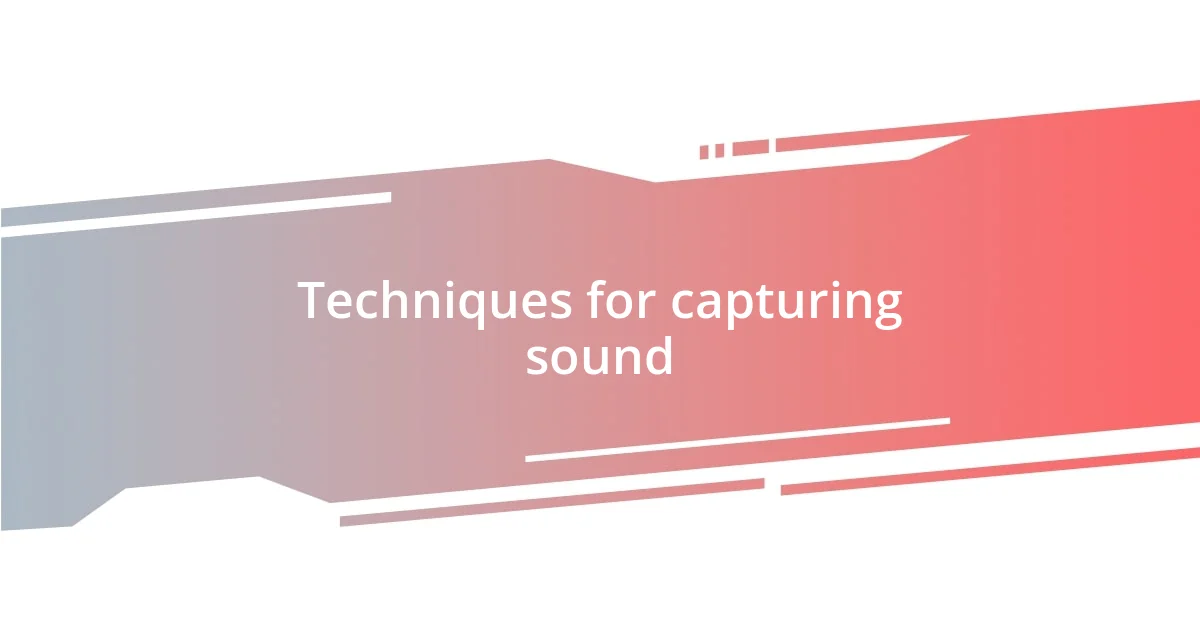Key takeaways:
- Percussion instruments significantly shape the emotional impact of music; understanding their unique characteristics is essential for musicians and producers.
- Choosing the right microphones and their placement can greatly affect the sound quality and texture of percussion recordings.
- Mixing percussion involves balancing levels, using EQ to carve space, and adding effects to enhance depth and clarity, ultimately creating a more engaging listening experience.

Understanding percussion instruments
Percussion instruments are fascinating because they encompass a wide range of sounds produced by striking, shaking, or scraping. I remember the first time I laid my hands on a djembe; the vibrations resonated through my entire body and ignited a passion that has only grown. Can you imagine how these diverse sounds can shape the emotional landscape of a piece of music?
Each type of percussion instrument brings something unique to the table, from the deep thud of a bass drum to the bright ring of a tambourine. When I started exploring recording techniques, I was often surprised by how different microphones could capture the nuances of each instrument. Have you ever considered how a small tweak in mic placement can alter the entire vibe of a track?
Understanding the rhythmic foundation that percussion provides is essential for any musician or producer. I find that percussion often acts as the heartbeat of a song, driving both energy and emotion forward. How do you think the choice of a particular percussion instrument influences the listener’s experience?

Selecting the right microphones
When it comes to selecting the right microphones for percussion instruments, I’ve learned that the type of microphone can greatly influence the final sound. For instance, dynamic microphones excel at handling loud sound sources, like a snare drum, without distortion. My first recording session with a dynamic mic was a revelation; the warmth and presence it captured truly brought the instrument to life.
On the other hand, condenser microphones are fantastic when you want to pick up the subtle nuances of softer percussion, such as cymbals or brushes on a snare. I vividly recall a session where using a condenser mic on a cajón created this rich texture, allowing the resonant tones to spill out and fill the room. It’s all about understanding the desired sound and pairing each percussion instrument with the right mic.
Additionally, don’t overlook the importance of mic placement. I remember experimenting with the distance and angle of the mic while recording a bongo session. The sweet spot I found added an unexpected depth to the rhythm, completely transforming the feel of the track. These experiences remind me that selecting the right microphones is not just a technical choice; it’s about enhancing the musical conversation.
| Microphone Type | Best For |
|---|---|
| Dynamic Microphones | Loud percussion like snare drums and toms |
| Condenser Microphones | Subtle sounds such as cymbals and shakers |

Choosing the perfect room
Choosing the right room for recording percussion instruments can dramatically impact the overall sound. I usually prefer a space that offers good acoustics, as I’ve found that the room creates a unique sonic backdrop that interacts with the instruments. I once recorded in a small, tiled bathroom—quite unconventional, right? But the way the sound bounced off those surfaces added a surprisingly vibrant quality that made my shakers and hand drums sing.
Here are some factors to consider when selecting your recording room:
- Room Size: Larger rooms can create a natural reverb, while smaller spaces often produce a tighter sound.
- Surface Materials: Hard surfaces (like tile or concrete) reflect sound, creating brilliance, while soft surfaces (like carpets or curtains) absorb sound, adding warmth.
- Isolation: Make sure the space is free from outside noise. A quiet environment allows the true character of the percussion to shine.
- Height: A room with high ceilings can enhance the resonance of drums, while low ceilings can offer a more intimate sound.
In my journey, I’ve learned to embrace experimentation. I once set up a recording session in a garage filled with various objects. The resulting percussive echoes and clangs transformed a simple track into something rich and layered, reminding me that the perfect room might not always be what you expect.

Setting up your recording gear
When it comes to setting up your recording gear, I start with a solid foundation—my audio interface. I remember my first interface; it was like connecting a key to a door that led to a world of creativity. Ensuring that you have one with enough inputs for all your mics is crucial, especially if you’re planning to layer multiple percussion elements. I often ask myself, “Is my interface giving me the best quality?” Trust me, the right interface can elevate your recordings from good to outstanding.
Next, I pay attention to my cabling. High-quality, shielded cables can make a noticeable difference in sound clarity. During a session once, I swapped out a couple of old cables for new ones, and the improvement in audio fidelity was staggering. It’s easy to overlook this step, but I encourage you to check every connection. A simple visual inspection can save hours of headache during the mixing phase.
Lastly, don’t forget your monitor setup. I always set my studio monitors at ear level and at a 60-degree angle to create an optimal listening environment. Early in my recording journey, I made the mistake of having my speakers too far apart, which muddied the sound. I’ve learned that proper placement not only enhances clarity but also allows me to make confident mixing decisions. How do you position your monitors? It’s more than just aesthetics; it’s about creating the perfect sonic space to bring your percussion to life.

Techniques for capturing sound
When it comes to mic placement, I often think of it as sculpting the sound. Personally, I prefer to experiment with different positions to find the sweet spot where the unique character of each instrument shines through. I recall a session where I placed a condenser mic about three feet away from a djembe. The result was a warm, resonant tone that captured its full depth, unlike anything I’d achieved before. Have you ever considered how slight changes in mic distance can transform the entire feel of a track?
Layering microphones can also be a game changer. I usually pair dynamic mics close to the source for punch and then add a condenser microphone further away to capture the room’s ambiance. One time, I recorded a session with this technique, and the blend created a rich soundscape that brought an entirely new life to our percussive tracks. Can you imagine the difference that can make in the final mix?
Don’t overlook the importance of phase alignment, either. This might sound technical, but it’s essential for ensuring that the sound from multiple mics works harmoniously rather than clashing. I had a particularly enlightening experience where I mistakenly reversed the phase on one mic during a recording session. Initially, I thought I’d lost a brilliant take until I corrected it—and the track instantly transformed. It’s moments like these that teach me just how critical these nuances are; they remind me to be meticulous in capturing sound.

Mixing and processing percussion tracks
When it comes to mixing percussion tracks, I find that balancing levels is crucial. I often start by establishing a rough mix before diving into any processing. I remember a project where I brought in a variety of hand percussion instruments; at first, they all seemed to clash in the mix. By adjusting the faders carefully, I discovered a sweet balance that allowed each instrument to be heard distinctly, creating a vibrant tapestry of sound. Have you ever felt overwhelmed by the sheer volume of elements in a mix?
After achieving a balanced level, I like to use EQ to carve out space for each percussion element. For instance, during one session, I realized that the tambourine was competing for attention with the kick drum. A gentle cut around 3-5 kHz on the tambourine provided clarity, letting the kick hold down the low end without sounding stiff. It’s fascinating how a small adjustment can breathe new life into tracks, don’t you think?
Finally, adding effects like reverb and compression can bring depth and cohesiveness to the mix. I recall a time when I was mixing a traditional folk piece; I decided to apply a touch of reverb to the snare, which enveloped it in a warm ambiance that matched the recordings beautifully. While I was initially hesitant, this decision transformed the entire piece into a more engaging listening experience. How do you approach effects in your mixes? For me, it’s about enhancing the story each percussion instrument has to tell.

Tips for achieving professional results
Achieving professional results in recording percussion instruments often hinges on attention to detail. I remember one instance when I was tracking a cajón—initially, it sounded flat. After repositioning the mic multiple times, I finally landed on a placement that brought out a beautiful resonance. Have you ever been surprised by how the room itself can shape the sound? It taught me to embrace the space I’m recording in and to be patient in the pursuit of that perfect tone.
Post-recording, I can’t stress enough the importance of proper editing. I once worked on a lively percussive track where I spent hours fine-tuning the timing of individual hits. The end result was astonishing. The precision added a polished quality that really elevated the whole piece. Isn’t it interesting how something as simple as timing can have such a significant impact?
Another key tip is to stay true to the genre while infusing your personal touch. During a session for a world music piece, I incorporated some unconventional rhythms, which not only excited the musicians but also added freshness to the mix. Balancing tradition with creativity is a tightrope walk—have you ever navigated that in your projects? I find that this blend often yields the most compelling results, inviting listeners on a journey that feels both authentic and innovative.















